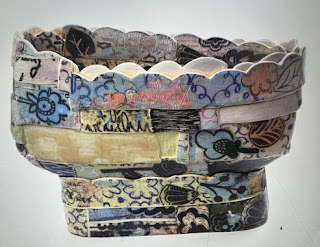March 30, 2023 - Glazes and Glazing
Last week we introduced glazes so that this week we could finish our work. This discussion will continue below (II).
I. Underglazes and "Low fire firings" (Temperature range cone 06, 05, 04)
In the last few weeks, we used Underglazes because of the wide range of colours available as well as, decorative techniques like sgrafitto and mishima. Our initial coloured test plates and tiles were fired (bisque fire:cone 05); touch ups were made and they were refired with a clear glossy glaze (1 coat of Duncan Pure Brilliance) and fired again (cone 05 - here we are not actually doing a "bisque" since the clay has already been vitrified but we are keeping the same low fire temperature because our glaze Duncan Pure Brilliance is made for low fire as per direction on the bottle. Many potters choose to do all of their work in low fire because of the colour brilliance and Greener Environmental concerns.
II. Midfire Glazing (Temperature range cone 5, 6)
At the guild we do midfire cone 6 glazing. We discussed how glazes are essentially fluid glass once heated to the right temperature. A glaze is composed of three basic parts: glass, a flux (controls melt) and stabilizer (clay: controls drip).
These glazes are applied mainly by dipping into the bucket or pouring. Generally the rule is no thicker than a dime. The glaze must be well stirred before use and check with your finger that you see you nail as demonstrated in class,
What is a Glaze?
|
Glaze: glass + stabiliser + melter |
Glass formers
SiO2 - Silica - our main glass former
Al2O3 - Alumina - a very high temp glass
former and glaze stiffener
B2O3 - Boron - low temp glass former
(Gerstley Borate; ferro frits: 3124; 3134; 3110; 3195)
Clays
(stabilizer) – keeps the glaze in suspension
● EPK (Edgar Plastic Kaolin) Al2O3 + SiO2
● Grolleg kaolin (china clay)
● OM4 Ball clay
● Red Art clay
● Bentonite - a powerful suspending agent
Primary
fluxes (R2O) - get the melting started
Primary Fluxes
Sources
|
Li2O -
Lithium Na2O -
Sodium K2O -
Potassium ‘ |
Lithium
Carbonate |
Secondary Fluxes (RO) - keep the melting going Sources (RO)
|
MgO - Magnesium CaO - Calcium SrO - Strontium BaO - Barium ZnO - Zinc |
● Whiting (calcium carbonate) CaO ● Wollastonite (calcium silicate) CaO, SiO2 ● Talc (magnesium silicate) MgO, SiO2 ● Dolomite CaO, MgO ● Magnesium carbonate MgO ● Zinc Oxide ZnO ● Strontium carbonate SrO ● Barium carbonate BaO ● Bone ash (tri-calcium phosphate) CaO, P2O |
.jpg)









.jpg)




